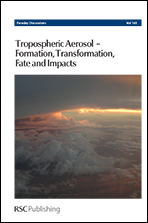Introductory lecture: Atmospheric organic aerosols: insights from the combination of measurements and chemical transport models
Abstract
The formation, atmospheric evolution, properties, and removal of organic particulate matter remain some of the least understood aspects of atmospheric chemistry despite the importance of organic aerosol (OA) for both human health and climate change. Here, we summarize our recent efforts to deal with the chemical complexity of the tens of thousands of organic compounds in the atmosphere using the volatility–oxygen content framework (often called the 2D-Volatility Basis Set, 2D-VBS). Our current ability to measure the ambient OA concentration as a function of its volatility and oxygen to carbon (O : C) ratio is evaluated. The combination of a thermodenuder, isothermal dilution and Aerosol Mass Spectrometry (AMS) together with a mathematical aerosol dynamics model is a promising approach. The development of computational modules based on the 2D-VBS that can be used in chemical transport models (CTMs) is described. Approaches of different complexity are tested against ambient observations, showing the challenge of simulating the complex chemical evolution of atmospheric OA. The results of the simplest approach describing the net change due to functionalization and fragmentation are quite encouraging, reproducing both the observed OA levels and O : C in a variety of conditions. The same CTM coupled with source-apportionment algorithms can be used to gain insights into the travel distances and age of atmospheric OA. We estimate that the average age of OA near the ground in continental locations is 1–2 days and most of it was emitted (either as precursor vapors or particles) hundreds of kilometers away. Condensation of organic vapors on fresh particles is critical for the growth of these new particles to larger sizes and eventually to cloud condensation nuclei (CCN) sizes. The semivolatile organics currently simulated by CTMs are too volatile to condense on these tiny particles with high curvature. We show that chemical aging reactions converting these semivolatile compounds to extremely low volatility compounds can explain the observed growth rates of new particles in rural environments.
- This article is part of the themed collections: Tropospheric Aerosol – Formation, Transformation and Impacts and The Spiers Memorial Lectures

 Please wait while we load your content...
Please wait while we load your content...